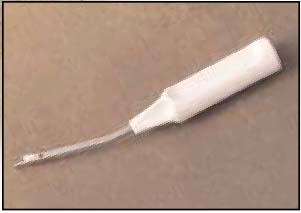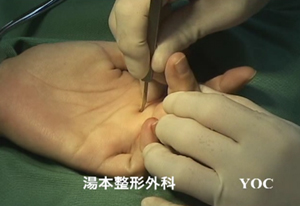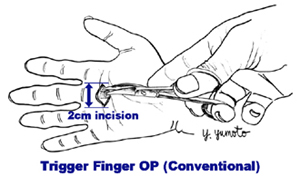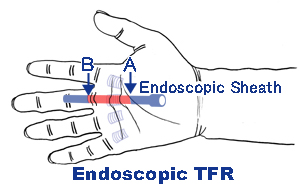 |
Yumoto Orthopaedic Clinic (JP HOME) is the Originator of Percutaneous Trigger Finger Release Surgery with Guided Knife |
Since 2011/07/31 |
|
||||
 |
Yumoto Orthopaedic Clinic (JP HOME) is the Originator of Percutaneous Trigger Finger Release Surgery with Guided Knife |
Since 2011/07/31 |
|
||||
| Overview Trigger Finger Surgery |
(1) Nomenclature1. PTFR・ PTFR is an abbreviation for Percutaneous Trigger Finger Release (surgery). ・ Percutaneous means that surgery has been carried out with a very small skin incision that only slim instruments could barely pass through, hence surgeon never has a chance to inspect inside anatomy. ・ PTFR surgery refers to any closed trigger finger surgery with 1 or 2 mm skin incision. 2. OTFR or Open Trigger Finger Release ・ At medical facilities, it is common that trigger finger release is carried out with 2 cm skin incision, unless otherwise stated. ・ De facto trigger finger release is OTFR worldwide. ・ Traditional OTFR's disadvantage has been and is delayed healing of skin wound, hence longer leave from work or normal daily life. 3. Pioneer of PTFR ・Trigger finger relase is a very simple surgery itself, J. Lorthioir had published the first report of trigger finger release done with small incisional, which he named "Subcutaneous Method". ・Nowadays, "Percutaneous" and "Subcutaneous" both refers to "small incisional". |
(2) Percutaneous Trigger Finger Release (PTFR)There are several ways that trigger fingers can be treated surgically.The following is the preoperative information I give to the patients. There is no patient who had preferred injection needle surgery or endoscopic surgery, both of which I have no experience. As Guided Knife could be purchased only within Japan at present, I hope this operation technique will predominate outside of Japan someday. |
|
First Generation PTFRFine tenotome (surgical knife)・As the pioneer of PTFR, J. Lorthioir operated on 52 patients with a fine tenotome (surgical knife), and reported his technique in 1958. He suggests in his report that the fibers of the tendon might be slightly divided. ・This is a comemorable report that it showed Open Surgery is not the only solution for treating Trigger Fingers surgically. |
|
Second Generation PTFRPTFR by injection needle・To make it safer and accurate, ulstrasound monitoring is introduced during this procedure. ・Digital nerves of thumb and index finger nevertheless are prone to injury. It is a consensus that patients must be well informed before operation that "The procedure might fail, and subsequent open release may be necessary." |
 ・Author of this Homepage has no experience of this operation. |
Third Generation PTFRBiomet Trigger Finger Knife (PDF)・Unlike percutaneous release using a needle, the Trigger Finger Knife is designed to avoid damage to the flexor tendons, avoiding possible complications of scarring and recurrent triggering. (from product leaflet). |
 |
Fourth Generation PTFRGuided Knife PTFR・Characteristic feature of GK-PTFR is swift ecovery of hand function and healing of skin incision postoperatively. ・Operative skin incision is only 2 mm, and no stitches are necessary. Patients can freely wash hands in tap water the very next day and on. |
 Photo from a video of Yumoto Orthopaedic Clinic |
|
|
|
(3) Open Surgery & Endoscopic Surgery |
|
| Open trigger finger surgery Open technique is the standard for surgical trigger finger treatment, and recommended in textbooks such as Campbell's Operative Orthopaedics, 11th edition, pp. 4300-4304. Skin incision of 1.5 to 2 cm in length will need 2 weeks to heal, and functional recovery would occasionally take longer. |
 |
| Endoscopic trigger finger release Endoscopic trigger finger release (ETFR) requires tunnel wound on the palm of hand as the illustration. Although each skin incision on both openings is as small as 2 to 4 mm in length and considerably smaller than open surgery, wound and functional recovery of hand as a whole would not be comparable with that of GK-PTFR. It is a common belief that thumb is excluded from indication. |
 ・Author of this Homepage has no experience of this operation. ・Author of this Homepage has no experience of this operation. |